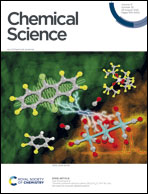Towards clustered carbonyl cations [M3(CO)14]2+ (M = Ru, Os): the need for innocent deelectronation†
Abstract
To access the hitherto almost unknown class of clustered transition metal carbonyl cations, the trimetal dodecacarbonyls M3(CO)12 (M = Ru, Os) were reacted with the oxidant Ag+[WCA]−, but yielded the silver complexes [Ag{M3(CO)12}2]+[WCA]− (WCA = [Al(ORF)4]−, [F{Al(ORF)3}2]−; RF = –OC(CF3)3). Addition of further diiodine I2 to increase the redox potential led for M = Ru non-specifically to divalent mixed iodo-RuII-carbonyl cations. With [NO]+, even the N–O bond was cleaved and led to the butterfly carbonyl complex cation [Ru4N(CO)13]+ in low yield. Obviously, ionization of M3(CO)12 with retention of its pseudo-binary composition including only M and CO is difficult and the inorganic reagents did react non-innocently. Yet, the radical cation of the commercially available perhalogenated anthracene derivative 9,10-dichlorooctafluoroanthracene (anthraceneHal) is a straightforward accessible innocent deelectronator with a half-wave potential E1/2 of 1.42 V vs. Fc0/+. It deelectronates M3(CO)12 under a CO atmosphere and leads to the structurally characterized cluster salts [M3(CO)14]2+([WCA]−)2 including a linear M3 chain. The structural characterization as well as vibrational and NMR spectroscopies indicate the presence of three electronically independent sets of carbonyl ligands, which almost mimic M(CO)5, free CO and even [M(CO)6]2+ in one and the same cation.
![Graphical abstract: Towards clustered carbonyl cations [M3(CO)14]2+ (M = Ru, Os): the need for innocent deelectronation](/en/Image/Get?imageInfo.ImageType=GA&imageInfo.ImageIdentifier.ManuscriptID=D2SC02358J&imageInfo.ImageIdentifier.Year=2022)
- This article is part of the themed collections: 2022 ChemSci Pick of the Week Collection and 2022 Chemical Science HOT Article Collection


 Please wait while we load your content...
Please wait while we load your content...